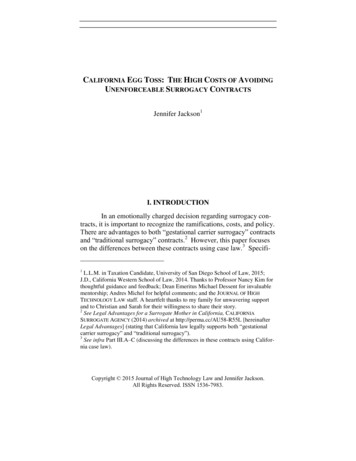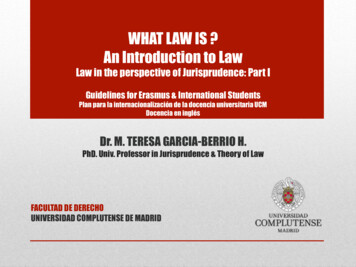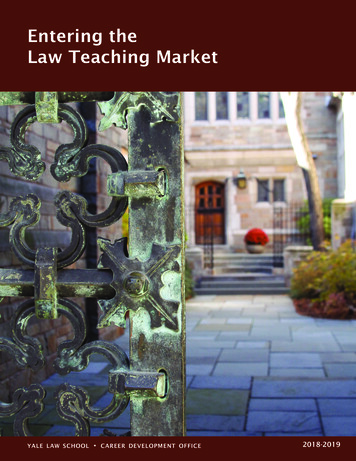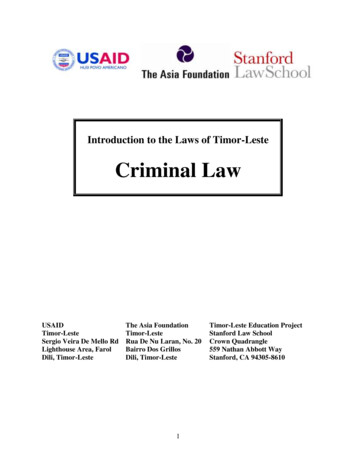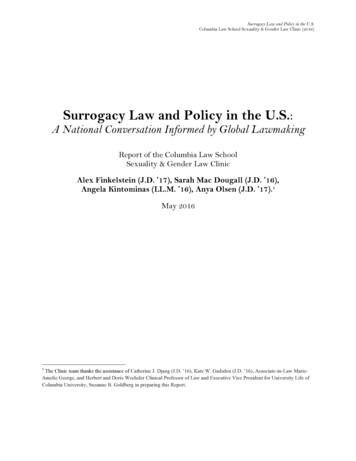
Transcription
Surrogacy Law and Policy in the U.S.Columbia Law School Sexuality & Gender Law Clinic (2016)Surrogacy Law and Policy in the U.S.:A National Conversation Informed by Global LawmakingReport of the Columbia Law SchoolSexuality & Gender Law ClinicAlex Finkelstein (J.D. ’17), Sarah Mac Dougall (J.D. ’16),Angela Kintominas (LL.M. ’16), Anya Olsen (J.D. ’17).1May 20161The Clinic team thanks the assistance of Catherine J. Djang (J.D. ’16), Kate W. Gadsden (J.D. ’16), Associate-in-Law MarieAmelie George, and Herbert and Doris Wechsler Clinical Professor of Law and Executive Vice President for University Life ofColumbia University, Suzanne B. Goldberg in preparing this Report.
Surrogacy Law and Policy in the U.S.Columbia Law School Sexuality & Gender Law Clinic (2016)Table of ContentsExecutive Summary . 3Part 1 – Definitions and Context . 5A. Definitions and Terminology . 5B. Overview of the Surrogacy Industry . 6C. U.S. State Law: Overview of Diverging Positions on Surrogacy . 81. States Where Surrogacy is Expressly Prohibited . 92. States Where Surrogacy Is Expressly Allowed . 93. States Where Surrogacy Is Not Clearly Addressed . 10D. Overview of Other Countries’ Positions on Surrogacy . 111. States That Prohibit All Forms of Surrogacy. 122. States That Leave Surrogacy Unregulated . 133. States That Expressly Permit and Regulate Non-Commercial Surrogacy . 144. Jurisdictions That Allow All Types of Surrogacy. 15Part 2 – Arguments and Issues . 18A.The Rights, Well-being, and Best Interests of the Child . 181. Commodification of Children. 182. Statelessness . 203. A Child’s Right to Know His/Her Biological Parentage and Heredity . 204. Judicial Interpretations of the Best Interest of the Child . 22B. Rights and Interests of the Surrogate . 241. Informed Consent . 242. Health Risks to the Surrogate . 283. Bodily Autonomy and Medical Decision-Making . 304. International Human Rights Law . 32C. A Broader Context: Systematic Objectification and Exploitation of Disadvantaged Women . 321. Impact on Disadvantaged Women . 332. Surrogacy as Exploitative of All Women . 35D. The Rights of the Intended Parent/s . 371. U.S. Constitutional Law . 372. International Human Rights Law . 383. Medical Infertility, Other Health Problems, and the Rights of People With Disabilities . 394. LGBQTI People, Unmarried Couples, and Single People. 40E. Fragmentation of the Traditional Conception of the Family and Parenthood. 40F. The Impact of State Intervention: Consequences of the Regulation of Domestic andTransnational Surrogacy Markets . 421. Broad Positions . 422. State Framing of the Practice of Surrogacy and Rights Protection . 42 1
Surrogacy Law and Policy in the U.S.Columbia Law School Sexuality & Gender Law Clinic (2016)Part 3 – Possible Legislative Provisions under Proposed New York Law . 46A. Access and Approval Processes. 461. Criteria Applying to All Parties . 462. Criteria Applying to Intended Parent/s . 473. Criteria Applying to the Surrogate . 48B. Legal Rights and Responsibilities . 491. Provisions in Surrogacy Contracts and Enforceability . 492. Reimbursement of Expenses to the Surrogate versus Compensation . 513. Transferral of Parentage . 52Appendices . 54Appendix A: U.S. State Laws Comparison Table . 55A.1. State Law Overview . 55A.2. Statutory Provision Comparison In States Where Surrogacy is Regulated . 64A.3 Possible Provisions List . 84Appendix B – International Laws Comparison Table . 86B.1 - Countries that Prohibit Surrogacy . 86B.2. Countries that Allow and Regulate Surrogacy . 87 2
Surrogacy Law and Policy in the U.S.Columbia Law School Sexuality & Gender Law Clinic (2016)Executive SummarySurrogacy raises many complex, contested, and ever-developing questions at theintersection of the law, science, ethics, and public policy. Surrogacy concerns both the mostintimate and deeply personal aspects of family life, but also important public matters aboutpromoting and protecting the best interests of vulnerable groups such as children, women, andminorities, both nationally and across international borders. This debate occurs in a contextwhere surrogacy is now a fast-growing and globalizing industry. At least several thousandchildren are born each year as a result of surrogacy arrangements, and this could be a significantunderstatement. This Report aims to inform advocates and citizens about importantdevelopments and fundamental issues concerning surrogacy. This information can be aparticularly useful tool in evaluating proposed changes in state surrogacy laws.Part 1 of this Report introduces the international surrogacy industry and how surrogacyis currently regulated in the U.S. and across the globe.U.S. states have responded to the policy issue of surrogacy in very different ways. Somestates expressly allow surrogacy. However, other states leave surrogacy partially or fullyunaddressed, and some expressly prohibit surrogacy altogether. Despite the wide degree ofinconsistency across the U.S., most states are moving away from prohibition and towardsregulation. New York is one of only four U.S. states that bans surrogacy entirely.There is no consensus on how to approach surrogacy around the world. In somecountries, surrogacy remains unregulated, but there is a general trend towards introducing lawsthat explicitly address surrogacy one way or another. Other jurisdictions permit and regulate onlynon-commercial surrogacy while prohibiting commercial surrogacy. Finally, there are somecountries that permit all forms of surrogacy, including commercial surrogacy. Many surrogacyfriendly jurisdictions have become or were previously destination states for foreigners. Manyconcerns have been raised about the lack of regulatory, legislative, and health standards, makingconditions dangerous and exploitative for surrogates and children in these locations. Notably,many destination countries are working to close down their international surrogacy markets.Part 2 of the Report canvasses the key arguments for and against the legalization ofsurrogacy.An important starting consideration is that many people have a strong desire to be aparent even though they may not be able to carry a child themselves. This includes LGBQTIcouples (especially gay men), single people, and people suffering from infertility, disability orother health problems. But the right to have a biological family needs to be balanced with otherrights and interests. A competing concern is what is in the best interests of children. Key issuesinclude the risk of a child becoming stateless, the right of a child to know their ancestry, and 3
Surrogacy Law and Policy in the U.S.Columbia Law School Sexuality & Gender Law Clinic (2016)broader concerns about the commodification of children. However, as a practical matter, statesmust also do what is in the best interests of children who are born through surrogacy even whereparents have contravened their laws. Also paramount are the rights and interests of surrogates.Key issues include surrogates’ bodily autonomy and informed consent. Critically, the situation ofindividual surrogates is also connected to the much broader concerns about the objectificationand exploitation of disadvantaged women worldwide. Furthermore, there are argumentsregarding the impact of surrogacy upon deeply held convictions regarding the family. Finally,this Part concludes with an overview of key issues regarding the impact of state intervention. Akey question is whether regulation serves to legitimize an inherently dangerous and exploitativepractice or whether it is the best route to mitigate the risks of surrogacy and promote the interestsof all involved.As this Report demonstrates, one of the difficulties in assessing the arguments for andagainst surrogacy is the lack of data on surrogacy as well as limited empirical studies into theconsequences of surrogacy across hugely varying contexts. Even where data and empiricalstudies are available, many of the arguments are grounded in ethical, philosophical, religious, orother normative positions that are difficult to empirically measure or to compare against eachother.Part 3 of this Report then moves to examine New York’s proposed bill, the Child-ParentSecurity Act, Assemb. B. 4319, 2015 Assemb., Reg. Sess. (N.Y. 2016), as a case study inanalyzing such proposed legislation. This Part considers the proposed criteria for intendedparents and surrogates, and how these criteria compare with the approaches taken in otherjurisdictions. Part 3 also examines the proposed requirements for the content and enforceabilityof surrogacy contracts including provisions regarding compensation, in comparison with otherjurisdictions. Finally, this Part considers and compares how the proposed bill assigns parentagepresumptions and manages the transfer of parental rights.Surrogacy is undeniably an immensely complex and controversial policy issue. Neitherinternational trends nor the practice in other U.S. states provides clear guidance forpolicymakers. Similarly, there are compelling arguments both for and against surrogacy, whichare often incommensurable to one another. However, in light of growing and globalizingsurrogacy trends, decisions made by individual states will have important ramifications not onlyfor the residents of this state but across the U.S. and the international community as a whole. 4
Surrogacy Law and Policy in the U.S.Columbia Law School Sexuality & Gender Law Clinic (2016)Part 1 – Definitions and ContextA. Definitions and TerminologySurrogacy is an issue that has developed a complicated set of acronyms and terms. Keyterms are defined here at the beginning of the Report for reference.The terms “surrogate,” “surrogate mother,” “gestational mother,” “birth mother”and “gestational carrier” refer to the woman agreeing to become pregnant and carry the child aspart of a surrogacy arrangement. Notably, the most appropriate term is often debated due to thenormative implications about motherhood suggested by the various terms. In this Report, theterm “surrogate” is used throughout.“Intended parent/s” (sometimes also described as “intending parent/s” or“commissioning parent/s”) refers to the individual/s who plan to receive the child into theirhome and raise the child as their own after the surrogate has given birth.“Full surrogacy” refers to a surrogacy arrangement in which all of the genetic materialinvolved originates either from the intended parents or donors. Full surrogacy requires the use ofassisted reproductive technology (“ART”). Full surrogacy is also referred to as “gestationalsurrogacy.” This term can create some confusion, particularly in case law, given that beforeART was available, partial surrogacy (explained below) was sometimes referred to as agestational agreement. However, the proposed bill in the New York state legislature refers to fullsurrogacy contracts as “gestational carrier agreements.”2By contrast, “partial surrogacy” refers to surrogacy arrangements in which thesurrogate’s genetic material is used to conceive the child as part of the contract. This method isalso sometimes referred to as “traditional surrogacy” because this was how surrogacyarrangements worked before ART developed. In this report, we will use the term partialsurrogacy, because it is more accurate and current in its usage.“Altruistic surrogacy” stands in opposition to “commercial surrogacy.” Commercialsurrogacy refers to surrogacy arrangements in which the surrogate is paid a fee above andbeyond reimbursement for “reasonable expenses.” Altruistic surrogacy, on the other hand, refersto arrangements in which the surrogate volunteers to perform a service without being paid,except potentially some payment for expenses. Notably, the distinction between what constitutes“reasonable expenses” and what constitutes “payment for services” has been and continues to bea difficult line to draw. Quite a few countries have legalized altruistic surrogacy while outlawingcommercial surrogacy. In the U.S., commercial surrogacy is most often referred to as“compensated surrogacy,” and altruistic surrogacy is called “uncompensated surrogacy.”2See Assemb. B. 4319, 2015 Assemb., Reg. Sess. (N.Y. 2016). 5
Surrogacy Law and Policy in the U.S.Columbia Law School Sexuality & Gender Law Clinic (2016)When intended parent/s travel overseas to engage a paid surrogate, this is called“international commercial surrogacy,” sometimes also described as “reproductive tourism”or “fertility tourism.”B. Overview of the Surrogacy IndustryThis section briefly introduces key information about the surrogacy industry both in theU.S. and globally, including: the size of the industry and factors contributing to its expansion, thenumber of children born each year via surrogacy arrangements, the costs involved, and the roleof intermediaries such as surrogacy agencies. Importantly, although surrogacy is a growing andglobalizing trend, the practice varies considerably from jurisdiction to jurisdiction. Factors suchas the costs involved, the role and regulation of surrogacy agencies, the quality of medical care,and the life circumstances of the surrogate and her relationship with the intended parents, all varydepending upon where the surrogacy arrangement is taking place. Thus, surrogacy is not, in allrespects, a singular phenomenon; some would argue that this must be taken into account whenmaking general statements about it.Surrogacy is a “booming, global business.”3 The Permanent Bureau of the Hagueestimates that the industry grew by 1000 percent internationally between 2006 and 2010.4 Othercommentators estimate that the industry is now worth up to 6 billion annually.5 Indeed, thenumber of international surrogacy arrangements each year has “grown significantly (if not,dramatically) over the past 5 years and is continuing to grow.”6 Several thousand children areborn each year through surrogacy worldwide, and “this could well be a significantunderstatement.”7 By way of caution, however, it is important to note that there is very limiteddata regarding surrogacy trends, including in particular, information about the number ofchildren born annually. This is due to the fact that even where surrogacy is legal, countries oftendo not distinctly track the incidence of surrogacy from other ART procedures.8 Additionally,reporting difficulties arise due to intended parent/s travelling across borders, or being reluctant toreport their arrangements because of social disapprobation and/or illegality.93PERMANENT BUREAU OF THE HAGUE CONFERENCE ON PRIVATE INTERNATIONAL LAW, Private International LawIssues Surrounding The Status of Children, Including Issues Arising From International Surrogacy Arrangements,Preliminary Doc. No. 11, March 2011, at 11, [hereinafter Hague Conference Document 2011], available at .pdf .4PERMANENT BUREAU OF THE HAGUE CONFERENCE ON PRIVATE INTERNATIONAL LAW, A Preliminary Report on theIssues Arising from International Surrogacy Arrangements, Preliminary Doc. No. 10, March 2012, at 6, [hereinafterHague Conference Document 2012] available at c361074e9b17fe.pdf .5Seema Mohapatra, Achieving Reproductive Justice in the International Surrogacy Market, 21 ANN. HEALTH L.190, 193 (2012).6PERMANENT BUREAU OF THE HAGUE CONFERENCE ON PRIVATE INTERNATIONAL LAW, A Study of Legal Parentageand Issues Arising From International Surrogacy Arrangements, Preliminary Document No. 3 C, March 2014, ],availableat https://assets.hcch.net/upload/wop/gap2014pd03c en.pdf .7Id. at 129.8Erin Nelson, Global Trade and Assisted Reproductive Technologies: Regulatory Challenges in InternationalSurrogacy, 41 J. L. MEDICINE & ETHICS 240, 241 (2013).9Id. 6
Surrogacy Law and Policy in the U.S.Columbia Law School Sexuality & Gender Law Clinic (2016)Many commentators have remarked that advances in ART technology has madesurrogacy vastly more popular and this underlies the significant growth in the industry in recentyears.10 Full surrogacy (using an embryo fertilized with the egg and sperm of the intendedparents or a third party donor) is now by far more common than partial surrogacy (where thesurrogate donates her own egg).11 By one estimation, ninety-five percent of all surrogacies in theU.S. utilize full surrogacy.12Although intended parents include married and unmarried same-sex couples and singlemales and females, most frequently clients appear to be married, heterosexual couples with amedical need for surrogacy.13Intended parents travel from all regions of the world in order to undertake internationalsurrogacy.14 As of 2014, surrogacy-friendly states such as California in the U.S. and India werethe most popular destinations.15 Other popular destinations included Thailand, Ukraine, Russia,Georgia, and Canada.16There is significant variation in how much surrogacy costs in different jurisdictions.Different costs associated with surrogacy include medical, legal and agency fees, payments madeto the surrogate and donors, as well as health insurance costs.17 Surrogacy arrangements in theU.S. are usually more expensive than other countries, but how much more so will depend uponthe facts of the case.18 Medical costs reportedly range from 11,600 reported in Ukraine, to 2,818 reported in Canada, to an average between 20,000 to 80,000 in the U.S.19 By way ofexample, legal costs in the U.S. have been estimated to be between 3,000 to 15,000.20 In theU.S., agency fees also vary widely, ranging between 6,000 to 54,000.21 Average fees forsurrogates in the U.S. is estimated to be between 20,000 to 55,000.22Intermediaries—such as surrogacy agencies, fertility clinics, health institutions, andmedical tourism companies—are now regularly involved in the surrogacy industry.23 Whetherand how these intermediaries are regulated varies considerably between jurisdictions.24 Agenciesprovide services including recruiting, assessing, and selecting surrogates; matching intended10Seema Mohapatra, Stateless Babies and Adoption Scams: A Bioethical Analysis of InternationalCommercial Surrogacy, 30 BERKELEY J. INT’L L. 412 (2012).11Id. at 135.12Richard F. Storrow, Surrogacy American Style, in SURROGACY, LAW, AND HUMAN RIGHTS 191, 200 (PaulaGerber & Katie O’Byrne, eds., 2015) (citing Diane S. Hinson and Maureen McBrien, Surrogacy Across America,FAMILY ADVOCATE 32, 34 (2011)).13Hague Conference Document 2014, supra note 3, at 140.14Id. at 132.15Hague Conference Document 2014, supra note 3, at 130.16Id.17Id. at 136.18Id. at 138.19Id.20Id.21Hague Conference Document 2014, supra note note 3, at 138.22Id.23Id. at 139.24Id. 7
Surrogacy Law and Policy in the U.S.Columbia Law School Sexuality & Gender Law Clinic (2016)parents with surrogates; and putting intended parents in contact with lawyers and hospitals,among other services.25 In the U.S., for example, surrogacy agencies are commonly involved inpairing intended parents with surrogates and they are usually independent of medical clinics.26The life circumstances of the surrogate (i.e., her socio-economic status, level of educationetc.) and the relationship she has with the intended parent/s differs significantly depending uponthe country.27 For example, in India surrogates are often significantly disadvantaged, and there isnormally very little contact between the surrogate and intended parent/s. However, this is notreflected in the U.S. where there is generally frequent contact between the surrogate and theintended parent/s, including at the matching stage, during the pregnancy, and sometimesfollowing birth.28Similarly, the quality of medical care varies tremendously between countries, and it islikely to be impacted by the level of regulation or self-regulation of the industry.29 The vastmajority of concerns that have been reported to the Permanent Bureau of the Hague Conferenceon Private International Law relate to India, Thailand, and Ukraine.30C. U.S. State Law: Overview of Diverging Positions on SurrogacyAcross the fifty U.S. states legal approaches to surrogacy vary widely, from completeprohibition to some of the most permissive approaches in the world. Indeed, as Richard F.Storrow remarks, the U.S. is “a microcosm of the rest of the world, with the whole range ofglobal attitudes towards surrogacy subsumed within its borders.”31Nearly half of the states have some legislation relating to surrogacy.32 Some states onlyhave case law governing surrogacy contracts, and some have no regulation at all.33 Model lawsintended to bring legal uniformity across the country have had limited success.34 Today,however, there is little legislative activity seeking to prohibit surrogacy.35 Storrow notes that thelegislative trend—if there is one at all—is toward legalizing surrogacy where it is illegal orproviding a statutory framework where the industry operates without legal regulation.3625Id. at 143.Id. at 143.27Hague Conference Document 2014, supra note 3, at 141.28Id.29Id. at 145.30Id. These concerns include: high number of embryo transfers, which result in multiple births; multiple surrogatesbeing impregnated at the same time by the same intended parent/s; gamete mix-ups (accidental use of incorrectsperm, ova or embryos during in vitro fertilization procedures); routine caesarean section births when not medicallynecessary; the deaths of the surrogate following childbirth; fetal reductions (when one or more fetuses are aborted incases of multi-fetal pregnancy to preserve the viability of the remaining fetuses and decrease health risks to themother); and sex-selective abortions.31Storrow, supra note 12, at 193.32Id. 194.33Id.34Id.35Id. at 198.36Id.26 8
Surrogacy Law and Policy in the U.S.Columbia Law School Sexuality & Gender Law Clinic (2016)This section overviews illustrative examples of where surrogacy is expressly prohibited,expressly permitted, as well as where the legal position remains unclear.371. States Where Surrogacy is Expressly ProhibitedCurrently, four states explicitly ban surrogacy: New York, New Jersey, Indiana, andMichigan. In three of these states—New York, Indiana and Michigan—surrogacy contracts arevoid and unenforceable.38In 1989, closely following the highly controversial Baby M case,39 New York GovernorCuomo introduced a bill to ban surrogacy within the state. The legislature passed it into law in1992,40 and since that time surrogacy contracts have been prohibited in New York state.However, the recently proposed Child-Parent Security Act seeks to repeal New York’s surrogacyban, in favor of regulating the practice.41 The specific provisions of the proposed Child-ParentSecurity Act are discussed below in Part 3 of this Report.2. States Where Surrogacy Is Expressly AllowedThere are fourteen states that regulate and permit some form of surrogacy via statute.42Even among these states, however, there is little consistency in their approach. For example,some surrogacy-friendly states allow compensation whereas others prohibit it. Some states haveno restrictions on who can be an intended parent, whereas others only allow access to marriedcouples with a medical need who are residents in that state. Similarly, some states have norequirements on who can be a surrogate, whereas others regulate this considerably. Furthermore,some states only legally address full surrogacy, and some address both full and partial surrogacy.Additionally, there is a great deal of variation in the process to establish legal parentage. Theexamples outlined below seek to highlight this variation among surrogacy-permissive states.In California, there is a law explicitly allowing and regulating full surrogacy contractsonly. California also allows compensation for the surrogate, and the law does not clarify whetherthere is a reasonableness limitation on the amount that can be paid. California has no restrictionson who can be a surrogate or an intended parent, and the law does not impose residencyrequirement on either intended parents or surrogates. The state also allows for pre-birthparentage orders (i.e., court order assigning legal parentage status to the intended parents prior tothe birth of the child), but these do not become effective until the moment of birth.37For a more thorough comparison along additional dimensions, please refer to Appendix A.See Appendix A.39See id.; In re Baby M, 537 A.2d 1227 (N.J. 1988).40Elizabeth Scott, Surrogacy and the Politics of Commodification, 72 J. L. & CONTEMPORARY PROBLEMS 109, 118(2009).41Assemb. B. 4319, 2015 Assemb., Reg. Sess. (N.Y. 2016), at Part 7, §§ 2-3.42Ala. Code § 26-17-801 (1984); Cal. Fam. Code §§ 7960-7962 (2013); Colo. Rev. Stat. § 19-4-106 (1987); Del.Code 13 § 8-807 (2013); Fla. Stat. §§ 63.213 (2003), 742.15 (2015); Ill. Comp. Stat. § 750-47 (2005); Me. Rev. Stat.19-A §1931, 1932 (effective July 2016); Nev. Rev. Stat. §§ 126.500-126.810 (2013); N.H. Rev. Stat. § 168-B(2014); Tex. Code § 160 (2001); Utah Code §§ 78B-15-801, 78B-15-809 (2008); Va. Code §§ 20-156–20-165(1991); Wash. Rev. Code §§ 26.26.210–26.26.260 (1989).38 9
Surrogacy Law and Policy in the U.S.Columbia Law School Sexuality & Gender Law Clinic (2016)Florida allows both full and partial surrogacy contracts, but a different law governs each.Both laws allow compensation for the surrogate for reasonable expenses, and in both types ofcontracts the intended parents agree to accept custody of and to assert full parental rights andresponsibilities for the child immediately upon the child’s birth. To enter a full surrogacycontract: (1) the intended parents must be married and older than eighteen; and (2) a licensedphysician must certify that the commissioning mother is either unable to
gestational agreement. However, the proposed bill in the New York state legislature refers to full surrogacy contracts as "gestational carrier agreements."2 By contrast, "partial surrogacy" refers to surrogacy arrangements in which the surrogate's genetic material is used to conceive the child as part of the contract. This method is
